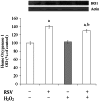Resveratrol protects C6 astrocyte cell line against hydrogen peroxide-induced oxidative stress through heme oxygenase 1
- PMID: 23691207
- PMCID: PMC3654976
- DOI: 10.1371/journal.pone.0064372
Resveratrol protects C6 astrocyte cell line against hydrogen peroxide-induced oxidative stress through heme oxygenase 1
Abstract
Resveratrol, a polyphenol presents in grapes and wine, displays antioxidant and anti-inflammatory properties and cytoprotective effect in brain pathologies associated to oxidative stress and neurodegeneration. In previous work, we demonstrated that resveratrol exerts neuroglial modulation, improving glial functions, mainly related to glutamate metabolism. Astrocytes are a major class of glial cells and regulate neurotransmitter systems, synaptic processing, energy metabolism and defense against oxidative stress. This study sought to determine the protective effect of resveratrol against hydrogen peroxide (H2O2)-induced cytotoxicity in C6 astrocyte cell line, an astrocytic lineage, on neurochemical parameters and their cellular and biochemical mechanisms. H2O2 exposure increased oxidative-nitrosative stress, iNOS expression, cytokine proinflammatory release (TNFα levels) and mitochondrial membrane potential dysfunction and decreased antioxidant defenses, such as SOD, CAT and creatine kinase activity. Resveratrol strongly prevented C6 cells from H2O2-induced toxicity by modulating glial, oxidative and inflammatory responses. Resveratrol per se increased heme oxygenase 1 (HO1) expression and extracellular GSH content. In addition, HO1 signaling pathway is involved in the protective effect of resveratrol against H2O2-induced oxidative damage in astroglial cells. Taken together, these results show that resveratrol represents an important mechanism for protection of glial cells against oxidative stress.
Conflict of interest statement
Figures









Similar articles
-
Resveratrol modulates GSH system in C6 astroglial cells through heme oxygenase 1 pathway.Mol Cell Biochem. 2017 Apr;428(1-2):67-77. doi: 10.1007/s11010-016-2917-5. Epub 2017 Jan 9. Mol Cell Biochem. 2017. PMID: 28070834
-
Guanosine protects C6 astroglial cells against azide-induced oxidative damage: a putative role of heme oxygenase 1.J Neurochem. 2014 Jul;130(1):61-74. doi: 10.1111/jnc.12694. Epub 2014 Mar 24. J Neurochem. 2014. PMID: 24673378
-
Glioprotective Effects of Resveratrol Against Glutamate-Induced Cellular Dysfunction: The Role of Heme Oxygenase 1 Pathway.Neurotox Res. 2025 Jan 27;43(1):7. doi: 10.1007/s12640-025-00730-w. Neurotox Res. 2025. PMID: 39869271
-
Role of resveratrol in regulation of cellular defense systems against oxidative stress.Biofactors. 2018 Jan;44(1):36-49. doi: 10.1002/biof.1399. Epub 2017 Nov 28. Biofactors. 2018. PMID: 29193412 Review.
-
Resveratrol modulates astroglial functions: neuroprotective hypothesis.Ann N Y Acad Sci. 2011 Jan;1215:72-8. doi: 10.1111/j.1749-6632.2010.05857.x. Ann N Y Acad Sci. 2011. PMID: 21261643 Review.
Cited by
-
Lumbar puncture-administered resveratrol inhibits STAT3 activation, enhancing autophagy and apoptosis in orthotopic rat glioblastomas.Oncotarget. 2016 Nov 15;7(46):75790-75799. doi: 10.18632/oncotarget.12414. Oncotarget. 2016. PMID: 27716625 Free PMC article.
-
Candesartan stimulates reparative angiogenesis in ischemic retinopathy model: role of hemeoxygenase-1 (HO-1).Angiogenesis. 2015 Apr;18(2):137-50. doi: 10.1007/s10456-014-9451-4. Epub 2014 Nov 25. Angiogenesis. 2015. PMID: 25420481 Free PMC article.
-
Neuroprotective effects of resveratrol in Alzheimer disease pathology.Front Aging Neurosci. 2014 Sep 11;6:218. doi: 10.3389/fnagi.2014.00218. eCollection 2014. Front Aging Neurosci. 2014. PMID: 25309423 Free PMC article. Review.
-
Oxabicycloheptene Sulfonate Protects Against β-Amyloid-induced Toxicity by Activation of PI3K/Akt and ERK Signaling Pathways Via GPER1 in C6 Cells.Neurochem Res. 2017 Aug;42(8):2246-2256. doi: 10.1007/s11064-017-2237-5. Epub 2017 Apr 4. Neurochem Res. 2017. PMID: 28374135
-
Glioprotective Effect of Resveratrol: an Emerging Therapeutic Role for Oligodendroglial Cells.Mol Neurobiol. 2018 Apr;55(4):2967-2978. doi: 10.1007/s12035-017-0510-x. Epub 2017 Apr 29. Mol Neurobiol. 2018. PMID: 28456938
References
-
- Fremont L (2000) Biological effects of resveratrol. Life Sci 66: 663–673. - PubMed
-
- Soleas GJ, Diamandis EP, Goldberg DM (1997) Resveratrol: a molecule whose time has come? And gone? Clin Biochem 30: 91–113. - PubMed
-
- Pervaiz S (2003) Resveratrol: from grapevines to mammalian biology. FASEB J 17: 1975–1985. - PubMed
-
- Delmas D, Jannin B, Latruffe N (2005) Resveratrol: preventing properties against vascular alterations and ageing. Mol Nutr Food Res 49: 377–395. - PubMed
-
- de la Lastra CA, Villegas I (2007) Resveratrol as an antioxidant and pro-oxidant agent: mechanisms and clinical implications. Biochem Soc Trans 35: 1156–1160. - PubMed
Publication types
MeSH terms
Substances
LinkOut - more resources
Full Text Sources
Other Literature Sources
Miscellaneous

